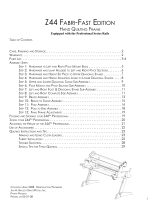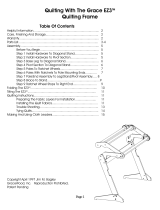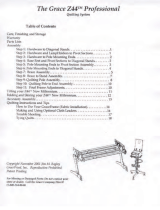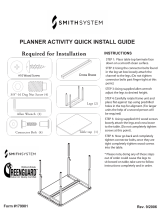
Your quilt fabrics may be tacked directly to the poles. However, using cloth leaders is a much better way to
attach your quilt (see Use of Optional Cloth Leaders instructions). Leaders are easy to make and allow the
quilter move the last few inches of the quilt forward from the rear pole to the front quilting area. If you choose
to use leaders, refer to those instructions for making them and put them on the frame before applying the quilt
fabric to the poles.
1. BACKING FABRIC
The first fabric that will be applied to the quilting frame is the Backing.
The Backing is also known as the lining fabric. This piece of fabric will be the under side of the finished quilt.
It is recommend that this piece of fabric be
2" to 4" larger than the top on all four sides,
especially if your top is a pieced top.
(A pieced top may possibly stretch out and
become larger than the backing if you do
not make this allowance). The Backing
fabric can be one continuous piece of
fabric or can be made by sewing fabric
together.
Piecing the Backing fabric:
Cut the selvedges before you
piece the back fabric together. The selvedge is woven more tightly than the rest of the fabric and won’t
have the same “give” as the rest of the fabric which can cause the seam to be too tight. Use a slightly
larger machine stitch than used in normal sewing when piecing the lengths of the back fabric together.
Many quilts have Back fabrics that are not one continuous piece of fabric and are pieced together using
two fabric pieces with a seam down the middle or three fabric pieces with two seams having been sewn.
You can also sew your back fabrics together using crosswise piecing.
Front Pole–Backing fabric
1. Mark the center of Backing fabric with a pin or a pencil mark.
2. Tack the center mark to the center of the front pole. (The Backing fabric is put on with the wrong
side of the fabric up and visible.)
3. Lay the fabric naturally and evenly along the straight edge of the pole. Do not stretch the fabric.
Tack the corners of the fabric to the pole.
4. Add a few more tacks to hold the material on the pole.
Middle Pole–Backing fabric
1. Tack the other end of the Backing fabric to the middle quilting pole, centering with the mark as
directed on the front pole.
2. Tack the center mark to the center of the middle pole.
3. Lay the fabric naturally and evenly along the straight edge of the middle pole. Do not stretch the
fabric. Tack the corners of the fabric to the pole.
4. Measure the amount of wood showing at the edges of the fabric to the end boards. This measurement
should equal the amount showing on the front pole.
5. Securely tack the Backing fabric along the entire edge of the middle pole, using plenty of tacks.
Rolling the Backing fabric onto the middle pole
1. Roll the material onto the middle pole, making a smooth roll. Be sure there are no wrinkles present.
2. Smooth the quilt from the center to the outside edges of the pole as it is being rolled. At this point do
not roll the fabric tightly, just roll it nicely smooth and even.
3. Roll until there is very little slack between the two poles.































